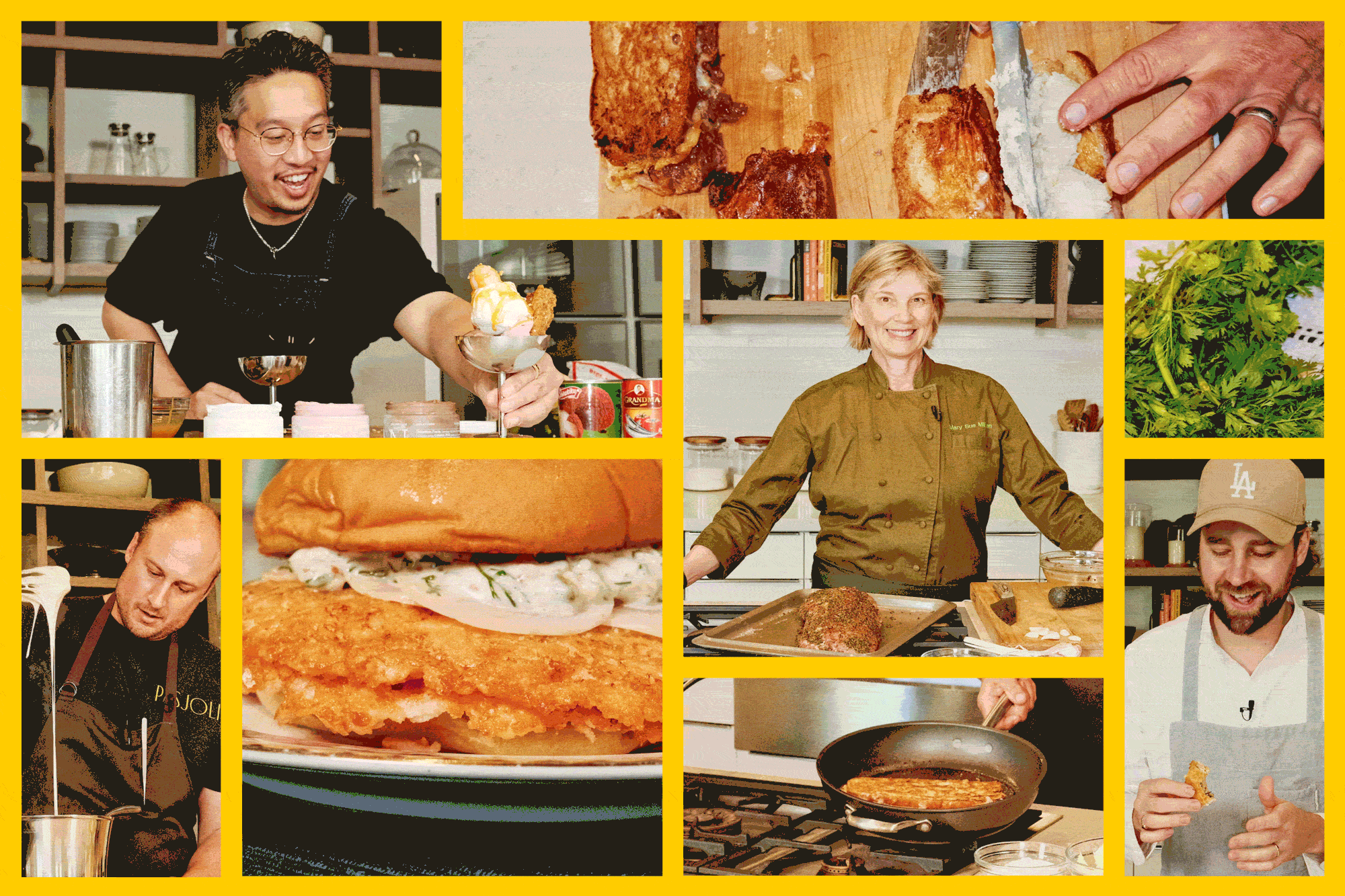‘Top Chef’ has all the right ingredients
In his thick Italian accent and broken English, former “Top Chef” contestant Fabio Viviani spoke of his dream, his secret dream, to a crowd huddled under a tent at the Farmers Market. It was, he said with a bowl of cilantro nearby, to “be filthy rich, grow 20 acre of cilantro, and drop a bomb on it. It tastes like soap.”
The audience of eager foodies laughed. Last season’s winner, Hosea Rosenberg, shook his head and chuckled. He was busy whipping up macadamia nut-and-oat crusted shrimp with coconut cilantro rice, and he had heard this tirade before. But he egged Viviani on anyway. “Yeah, do the Fabio thing, whatever it is. They’ll love it.”
The pair came to Los Angeles last month on the final stop of the “Top Chef” tour, a 22-city showcase demonstrating just how big Bravo’s cooking prowess has become. The competition show, which premiered on the cable network in 2006, is as dramatic as TV’s cooking bouts come, pitting working chefs against one another for a $100,000 cash prize and -- even more important for a chef -- bragging rights. Contestants, under considerable time pressure, have tackled exotic proteins like snake and geoduck, enlivened airplane food, catered to the whims of the Foo Fighters and hawked their own versions of upscale street food.
The Emmy-nominated show, which has been honored with the culinary industry’s prestigious James Beard Award, has in its fifth season averaged almost 4 million viewers -- a figure that exceeds anything on the Food Network -- and is regarded as Bravo’s top franchise. Its sixth season premieres Aug. 19.
“I think Bravo struck gold with their timing,” Rosenberg said. “Right now, people’s interest in food and chefs is at an all-time high. I’m still shocked at how many kids watch the show. I walk out in my restaurant and they’re freaking out. They’re hyperventilating.”
Unlike like other competitive food series in which amateur chefs are berated (Fox’s “Hell’s Kitchen”), handed a deliberately impossible mix of ingredients (Food Network’s “Chopped”) or asked to sell their personalities along with their recipes (“The Next Food Network Star”), “Top Chef’s” high-stakes drama is fired by the inherent stresses of being on the line when dinner service actually begins. Take lamb past medium rare? Can’t shuck an oyster? Make your guests wait? Judgment is harsh and swift.
Tom Colicchio, chef-owner of the Craft restaurants and “Top Chef’s” head judge, had to be persuaded that producers were committed to a fair test of skills before agreeing to participate. “Once I realized it wouldn’t be a reality show about eating bugs but one about people with talent, I said, ‘All right, I’ll give it a shot,’ ” he said.
Eric Ripert, chef-owner of New York’s three- Michelin-starred Le Bernardin, said that after watching the first season he begged his publicist to book him a spot as a guest judge. “The last thing I want to do is let a bunch of TV lunatics use my brand to promote their craziness, but this show has credibility,” Ripert said. His favorite dish? Ilan Hall’s fideos with clams.
Fashionable assist
The show’s genesis began after Bravo scored with “Project Runway,” the fashion competition series that proved there was an audience for reality TV fueled by the creative process. The cable channel wanted to duplicate that success in the restaurant world.
The network tapped “Runway” producers Jane Lipsitz and Dan Cutforth to develop the idea, and they interviewed chefs of all skill levels about the eccentric lifestyle and the backbreaking work.
“It’s a vampire existence, really, and a life of service on some level,” Cutforth said. “But at the same time, they all said the kitchen was the only place where they could really express themselves.”
“Like most really creative people, most of them are a little bit off-center,” added Lipsitz. “It was hard not to find great characters.”
Witness Season 2’s Marcel Vigneron, who in classic reality TV style sported a Wolverine-esque look and rapped about his skills; he placed second and now works at Jose Andres’ Bazaar in L.A.
“There’s a reason these people succeed in the kitchen. They’re competitive by nature, and they’re highly creative,” said Frances Berwick, Bravo’s executive vice president of programming. “That also happens to make them good television.”
Some of “Top Chef’s” unusual challenges have stumped even seasoned competitors. Just ask Wylie Dufresne, who became unhinged during the second episode of “Top Chef Masters,” a high-end spinoff that assembled some of the country’s most decorated chefs and concludes this month. Still-standing contestants include Rick Bayless, Hubert Keller, Anita Lo and Michael Chiarello.
Dufresne, the chef-owner of Manhattan’s wd-50, said he was frustrated by the task at hand. His plans to transform vending machine snack food (a prepackaged sandwich and a can of Dr. Pepper) into haute cuisine (grilled cheese with red onion and a reduction of Dr. Pepper) hadn’t worked out so well.
“I was surprised at how badly I did,” he said. (Fried shallot rings with Dr. Pepper aioli by Suzanne Tracht of Jar won the day.)
Still, it’s difficult to imagine any of the chefs previously trying to make a meal from the ingredients in a single aisle of the grocery store or cook an egg with just one hand or prepare holiday dishes inspired by lines from “The 12 Days of Christmas.”
“I’ve rolled my eyes at some of the things we’ve asked them to do,” Colicchio said. “But it’s fair because all the contestants have to do it. And as you’ve seen, most of them rise to the challenge.”
Deciding whom to ax from the show can take hours as the worried contestants sweat their fate in a space known as the Stew Room. “There have been times when it’s 4 in the morning and we’re tired and we’ll keep going until we have a decision,” Colicchio said. “I think that honesty comes through.”
Growing and growing
With “Project Runway” now moved to Lifetime, “Top Chef” is king of the Bravo empire, and it continues to expand its influence.
In the book world, “Top Chef: The Cookbook” became a New York Times bestseller, and a follow-up, “Top Chef: The Quickfire Cookbook,” will be released in October. Meanwhile, “Top Chef” branded chef knives, bouquets from Teleflora (some scented with cinnamon sticks and orange slices, others featuring a mix of flowers, fruit and vegetables) and a line of luxury wines are also on the way, as is a subscription-based online cooking class taught by past contestants.
A second edition of “Top Chef Masters” is being discussed, as is another spinoff, “Top Chef Juniors,” in development at the network.
The show’s alumni have capitalized on their newfound fame. Hall, the Season 2 winner, plans to open up his own restaurant, the Gorbals, in downtown L.A. this month. And this year’s runner-up, Stefan Richter, will take over Santa Monica’s L.A. Farm, which will be renamed Stefan’s at L.A. Farm.
And “Top Chef’s” inaugural winner, Harold Dieterle, opened his own place, Perilla, two years ago in New York City. There’s still a wait to get in. (Later this year, viewers will be able to catch up with other past contestants with a special “Top Chef: Where Are They Now?”)
The new season of “Top Chef” is set in Las Vegas and boasts the show’s highest-caliber lineup yet. Among them: a Michelin star recipient, more than one James Beard Award nominee and several who have trained with world-class chefs.
“All I can tell you about Season 6 is that it’s by far the best food we’ve had,” Colicchio said. “I know you think I’m just saying that, but it was really, really good.”
denise.martin@latimes.com
More to Read
Eat your way across L.A.
Get our weekly Tasting Notes newsletter for reviews, news and more.
You may occasionally receive promotional content from the Los Angeles Times.









